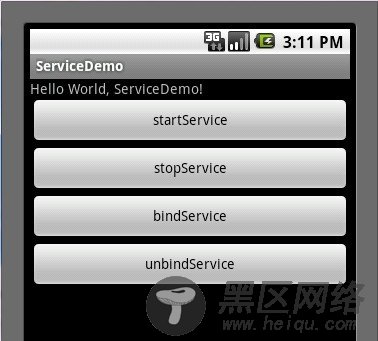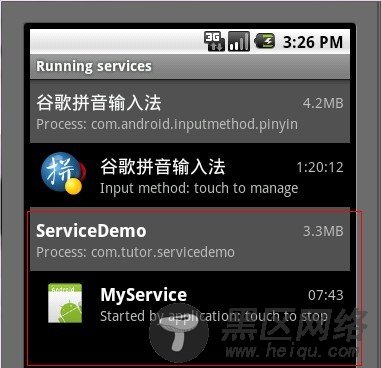package com.tutor.servicedemo;
import android.app.Activity;
import android.content.ComponentName;
import android.content.Context;
import android.content.Intent;
import android.content.ServiceConnection;
import android.os.Bundle;
import android.os.IBinder;
import android.view.View;
import android.view.View.OnClickListener;
import android.widget.Button;
import android.widget.TextView;
public class ServiceDemo extends Activity implements OnClickListener{
private MyService mMyService;
private TextView mTextView;
private Button startServiceButton;
private Button stopServiceButton;
private Button bindServiceButton;
private Button unbindServiceButton;
private Context mContext;
//这里需要用到ServiceConnection在Context.bindService和context.unBindService()里用到
private ServiceConnection mServiceConnection = new ServiceConnection() {
//当我bindService时,让TextView显示MyService里getSystemTime()方法的返回值
public void onServiceConnected(ComponentName name, IBinder service) {
// TODO Auto-generated method stub
mMyService = ((MyService.MyBinder)service).getService();
mTextView.setText("I am frome Service :" + mMyService.getSystemTime());
}
public void onServiceDisconnected(ComponentName name) {
// TODO Auto-generated method stub
}
};
public void onCreate(Bundle savedInstanceState) {
super.onCreate(savedInstanceState);
setContentView(R.layout.main);
setupViews();
}
public void setupViews(){
mContext = ServiceDemo.this;
mTextView = (TextView)findViewById(R.id.text);
startServiceButton = (Button)findViewById(R.id.startservice);
stopServiceButton = (Button)findViewById(R.id.stopservice);
bindServiceButton = (Button)findViewById(R.id.bindservice);
unbindServiceButton = (Button)findViewById(R.id.unbindservice);
startServiceButton.setOnClickListener(this);
stopServiceButton.setOnClickListener(this);
bindServiceButton.setOnClickListener(this);
unbindServiceButton.setOnClickListener(this);
}
public void onClick(View v) {
// TODO Auto-generated method stub
if(v == startServiceButton){
Intent i = new Intent();
i.setClass(ServiceDemo.this, MyService.class);
mContext.startService(i);
}else if(v == stopServiceButton){
Intent i = new Intent();
i.setClass(ServiceDemo.this, MyService.class);
mContext.stopService(i);
}else if(v == bindServiceButton){
Intent i = new Intent();
i.setClass(ServiceDemo.this, MyService.class);
mContext.bindService(i, mServiceConnection, BIND_AUTO_CREATE);
}else{
mContext.unbindService(mServiceConnection);
}
}
}
第五步:修改AndroidManifest.xml代码(将我们新建的MyService注册进去如下代码第14行:)
<?xml version="1.0" encoding="utf-8"?>
<manifest xmlns:android="http://schemas.android.com/apk/res/android"
package="com.tutor.servicedemo"
android:versionCode="1"
android:versionName="1.0">
<application android:icon="@drawable/icon" android:label="@string/app_name">
<activity android:name=".ServiceDemo"
android:label="@string/app_name">
<intent-filter>
<action android:name="android.intent.action.MAIN" />
<category android:name="android.intent.category.LAUNCHER" />
</intent-filter>
</activity>
<service android:name=".MyService" android:exported="true"></service>
</application>
<uses-sdk android:minSdkVersion="7" />
</manifest>
第六步:执行上述工程,效果图如下:

点击startServie按钮时先后执行了Service中onCreate()->onStart()这两个方法,打开Logcat视窗效果如下图:

我们这时可以按HOME键进入Settings(设置)->Applications(应用)->Running Services(正在运行的服务)看一下我们新启动了一个服务,效果如下:

点击stopService按钮时,Service��执行了onDestroy()方法,效果图如下所示:

